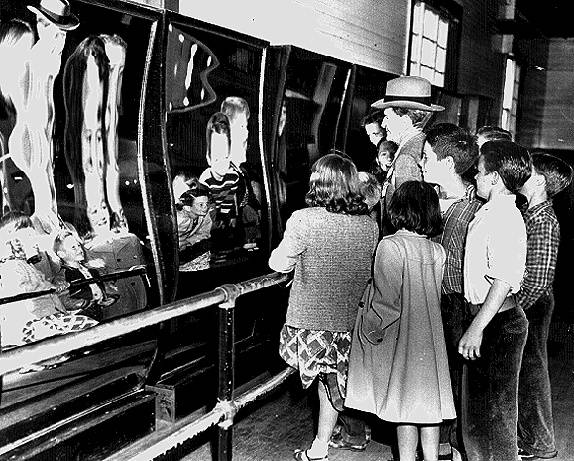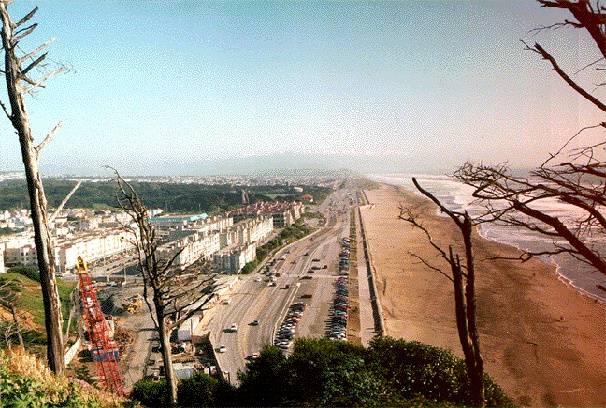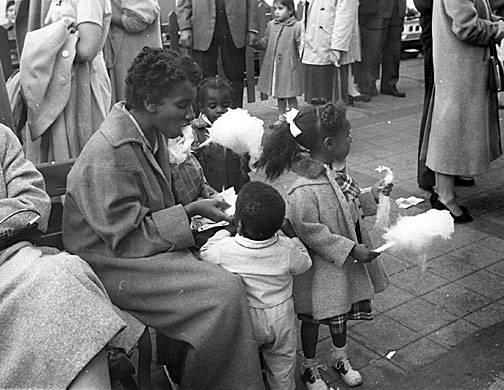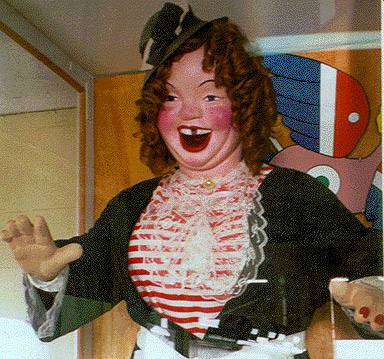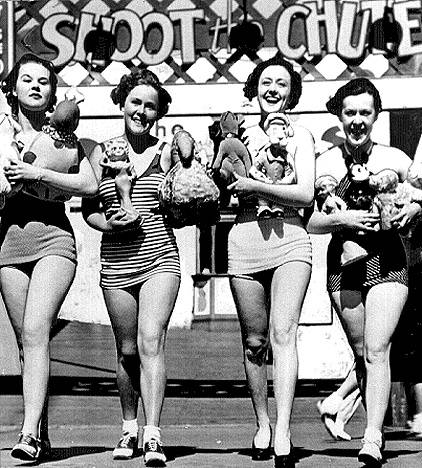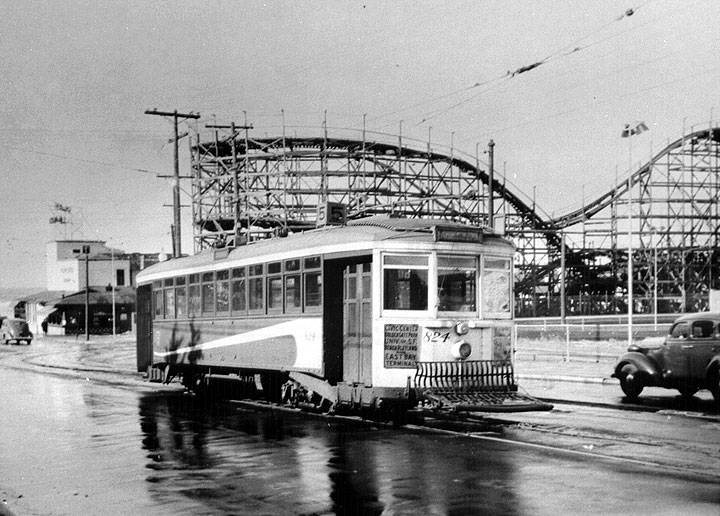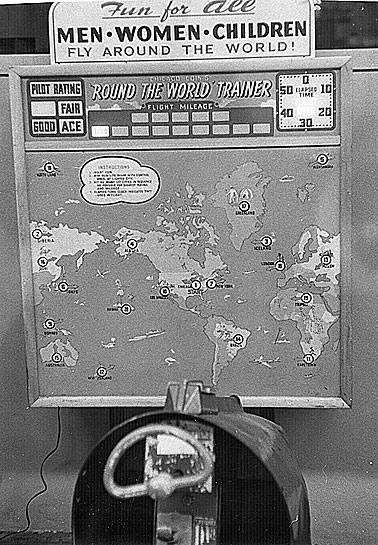Playland
Playland at the Beach, Great Highway and Fulton Streets, c. 1930s.
Photo: San Francisco History Room, SF Public Library
Playland died along with blue collar image that once embodied a gritty San Francisco
San Francisco has always been somewhere people come to enjoy themselves, and tourism has long been a mainstay of the city's economy.
Nightlife, culinary delight, amusement, erotic adventure and family entertainment are all contained within its 49 square miles. Anything a visitor may seek, San Francisco can provide. Echoes of fun and amusement ring throughout the city from the cable cars atop Nob Hill to the sea lions barking at the wharf.
Turning back the clock to the Depression, we find San Francisco bubbling as a haven of fun even then.
The place to go was a now-vanished amusement park, Playland-at-the-Beach. During the Depression and World War II, Playland thrived. Adults and children, families and couples on dates, sailors from all over the world went to Playland to ride bumper cars and roller coasters and explore the thrills of the Funhouse. For many San Franciscans, Playland was and still is their childhood, 33 years after its demolition.
Playland was located at Ocean Beach, just north of Golden Gate Park, below the point where the land rises to Sutro Heights. The attractions in this corner of the city had the added novelty of being where Western civilization meets the Pacific Ocean -- in a way, at the end of the world.
From the mural-bedecked Beach Chalet at the western end of the park to Playland to the Cliff House and Sutro Baths, the recreational options lined up in a long row. Much of this ended up as part of the pleasure empire of the man called the Barnum of the Golden Gate, George Whitney.
A little amusement area named Ocean Beach Pavilion had existed since 1884. In 1912, Arthur Looff and his partner, John Friedle, built Looff's Hippodrome, housing a grand carousel built by Looff's father. In 1922, the two added the Big Dipper roller coaster and the Chutes-at-the-Beach water ride. Whitney and his brother Leo came to town and opened a photofinishing concession booth in a smaller version of Playland.
In 1926, Whitney became general manager, and the park became Whitney's Playland-at-the-Beach. He bought out shaky concessionaires during the Depression. By 1942, he owned everything from Sutro Baths to Fulton Street.
Funhouse Mirrors at Playland
Photo: San Francisco History Room, SF Public Library
Whitney's Playland grew to more than three blocks of amusements next to the Great Highway. It included Topsy's Roost Restaurant, which later became Skateland; a midway of games and vendors; a diving bell; and, of course, the Funhouse with long wooden slides, a human turntable that spun and threw people off if they didn't hang on, distorting mirrors and air jets that blew women's skirts up.
Playland was also the birthplace of the It's-It, Whitney's invention of ice cream sandwiched by two oatmeal cookies and covered in chocolate.
Only the newly remodeled and now far more upscale Cliff House and Beach Chalet still stand. A condominium development erased any trace of Playland.
View from Sutro Heights, 1995.
Photo: Chris Carlsson
Young family enjoys cotton candy at Playland, 1960s.
Photo: Kurt Bank
Blue-collar times
Anyone who remembers Playland is wistful, or maybe just nostalgic, for the gritty, blue-collar San Francisco. "It wasn't just toys for the rich. It was toys for everyone," said Dan Fontes, a muralist working in El Cerrito on a large rendering of Playland and the surrounding area.
San Francisco has changed. The blue-collar neighborhoods are mostly gone, and amusement is often more solitary than when the Playland fun house rang with screams and laughter. Still, Playland has not been lost. Anyone can find it. Its fragments are scattered all over the city.
Playland is best remembered by a laugh, the one that belonged to a huge mechanical woman who towered above the entry to the Funhouse from the 1940s until it closed in 1972 and she was auctioned off. Her name was Laughing Sal.
Anyone walking down Playland's Midway -- even nearby neighbors -- heard Sal's bellowing laugh. She had devilish curly red hair and huge freckles all over her fat, terrifying visage. In the middle of it all was a gap-toothed smile that provided nightmare material for countless children. This was creepy, the same way a ventriloquist's dummy is.
"She would stand there laughing and laughing, and you would stand there laughing and laughing, and you didn't know why," said Sharon Jessup, a San Francisco native who grew up going to Playland. Sal's continuous laugh was a drunken yelping guffaw, an evil cackle, the uninhibited outburst of someone going out of her mind. With arms extended, she heaved back and forth with a bit of a bobbing motion in her huge glass box.
Sal was constructed by the Old King Cole papier-mache company under commission to the Philadelphia Toboggan Co., maker of amusement park furnishings. Old King Cole started with a mechanical laughing department store Santa Claus. They fitted the Santa with a woman's legs, breasts that jiggled on the end of springs and custom-made heads. With the addition of a 78 rpm recording of the most memorable laugh in the world, Laughing Sal was born.
Laughing Sal
Photo: Chris Carlsson
By the 1960s, Playland was run down and a little seedy. Some say it started downhill when Whitney tore down the Big Dipper roller coaster in the late 1950s. Sutro Baths burned during its demolition in 1966, and Whitney stopped operating Playland in 1968.
The park took on a roving carnival feel, said Marvin Gold, who grew up nearby, going to sleep every night to the sound of Sal's cackle. In 1972, Playland was put up for sale. When it closed on Sept. 4, 1972, Herb Caen wrote a column called, "We'll Never Go There Anymore." He reminisced over It's-Its, Bull Pup enchiladas, a 40-cent corn dog and a ride on the carousel.
Today, Playland is covered with housing. A Safeway stands on the site of the old diving bell. Gold said he remembers when workers came to smash the concrete foundation and heard a clang. They found the concrete lined with a steel tank, filled it in and built on top of it.
"One hundred years from now when they tear Safeway down, they're going to find an old steel tank sitting there and have no idea what it was," he said.
"Oh, and those slides, those beautiful wooden slides," he said of the long hardwood slides in the Funhouse. "When I saw them cutting those slides into pieces ... I nearly cried. "Playland was our second home."
For the next 30 years after Playland closed, people didn't have to look far to find Laughing Sal. Although the main Funhouse Sal went to the Santa Cruz Boardwalk for $50,000, Playland's back-up Sal found a home in the basement of the Cliff House, along with the penny arcade machines. They all were put into the Musée Mecanique, a collection that Ed Zelinsky he obtained from George Whitney.
All of the machines are still working, offering love tests, telling fortunes and showing the first silent films. Video games were added to a small arcade at the back -- early games like Pac Man and eventually the 3-D driving and shooting simulators we see now.
In 2002, the Musée was imperiled when the Cliff House was renovated. San Franciscans came to the rescue with a petition carrying more than 25,000 signatures. They were outraged that the Parks and Recreation Department, which owns the Cliff House, hadn't tried to find the historical Musée a new home.
Thanks to the public outcry, a home was found at Pier 45, where a row of crab stands leads to a building painted with a giant version of Laughing Sal's face. Her missing tooth is the entry to Amusing America, which chronicles San Francisco's place in the country's cultural history of amusement parks.
Playland, Sutro Baths and the 1939 World's Fair are all featured in interactive and informative displays, with the Musée Mecanique collection in the back. And at the door, as in her two previous homes, Sal is the greeter and gatekeeper who still bursts into laughter for a quarter. Maybe she's laughing at her luck, having survived the urban development that has put her into a museum version of a city that no longer exists.
Maybe she's laughing at what amusement in San Francisco has become around her: a Fisherman's Wharf that has become a commercial tourist center with many of the same type of attractions as Playland. Dan Fontes, the muralist and a good source of history on Sutro Baths and Playland, says that when Playland was alive, "Fisherman's Wharf was a fisherman's wharf, with fishermen."
Now, it is the Playland of today, the city's waterfront amusement center, even if it is there mostly for tourists. Playland's remains are scattered elsewhere around the city, too.
Carousel in Yerba Buena
The marvelous carousel built by Charles I.D. Looff in 1906 and installed at Playland in 1912 eventually found its way back to San Francisco. Marianne Stevens, a preservationist, had bought it from Playland and restored it for a Long Beach mall. In 1998, the San Francisco Redevelopment Agency bought it for $1 million and installed it in a beautiful glass pavilion at Yerba Buena Gardens.
The ocean wind even blew Playland's ashes all the way to El Cerrito, where muralist Fontes and partner Ed Cassel are working with Playland collector Richard Tuck to create a tribute to that vanished beach area.
They're creating a mural 32 feet long and 10 feet high depicting Playland, Sutro's Baths and Museum and the Cliff House. Fontes said the reactions of former Playland visitors range from surprised delight to tears.
In 1996, on the very ground where Playland once stood, five ghosts of those bygone days arose. From a distance, the five 15-foot-high figures across the street from Safeway on 48th and Cabrillo look like ghostly black shadows. Up close, they're monuments called Playland Revisited created by Ray Beldner, an artist who often visited Playland as a child.
Made of perforated stainless steel, each tall, narrow sculpture represents a Playland icon. There's Laughing Sal of course, a Muni streetcar, the clown entrance to the Funhouse, the rooster from Topsy's Roost and a carousel horse.
The statues at the bus terminus also mark the terminus of San Francisco, of the solid world before it hits the sea, and the terminus of a time when that spot was filled with thousands of people of all classes and types enjoying themselves.
The icons give tangible body to the ghosts of Playland that live in the hearts and memories of so many grown-ups. They ensure that Playland isn't entirely gone and that childhood won't be forgotten.
--Lubna Takruri, July 3, 2005
Lubna Takruri was in 2005 a student at the UC Berkeley Graduate School of Journalism, a freelance print reporter, and an assignment editor at KRON-4 News. This article originally appeared in the San Francisco Chronicle, Insight section.
Bathing beauties laugh it up at Playland, c. 1940s
Photos: San Francisco History Room, SF Public Library
International Studies at Playland
Photo: Kurt Bank

